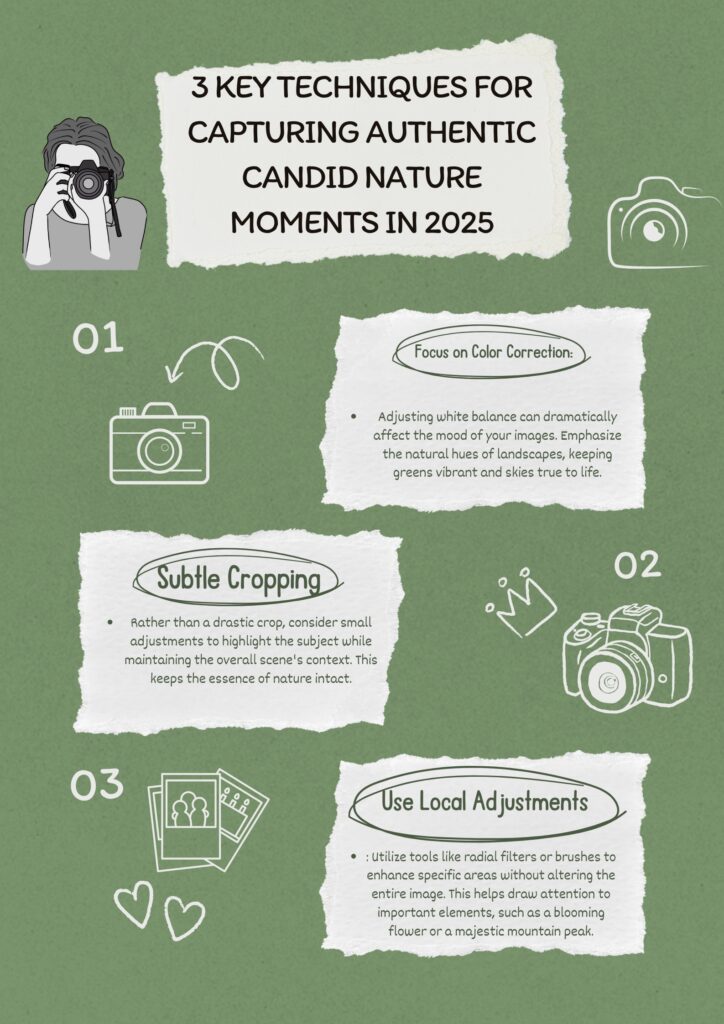Ever admired breathtaking nature shots on social media and wished you could capture the same magic? As we enter 2025, mastering candid nature photography is key to standing out. In this article, we’ll share three essential techniques to help you turn fleeting moments into stunning, authentic visuals.
Understanding the Importance of Authenticity
Authenticity in nature photography is more than just capturing a beautiful image; it reflects a genuine connection between the photographer and the environment. When photographers embrace authenticity, they convey the true essence of a scene, allowing viewers to experience the wonder of nature as it is, rather than through a filtered lens of artificiality. This honest representation fosters a deeper appreciation for the natural world, encouraging conservation efforts and a sense of responsibility toward protecting these landscapes.
Moreover, authenticity in nature photography can inspire creativity and self-expression. Photographers who remain true to their vision often discover unique perspectives that resonate with others. By sharing unembellished moments of beauty, whether the intricate details of a dew-covered spiderweb or the vastness of a mountain range, these artists invite audiences to engage with nature on a personal level. In an age where digital manipulation is commonplace, authentic imagery stands out, offering a refreshing reminder of nature’s raw beauty and complexity.
Choosing the Right Gear for Nature Photography
When it comes to nature photography, the right gear can make all the difference in capturing breathtaking moments. Start by considering a versatile camera that balances quality and portability; DSLR and mirrorless models are popular choices among enthusiasts. Pair your camera with a sturdy tripod to stabilize your shots, especially in low-light conditions or when using slower shutter speeds. Don’t forget about lenses! A good zoom lens allows you to capture wildlife from a distance, while a wide-angle lens is perfect for sweeping landscapes.
Beyond the basics, think about accessories that enhance your experience in the field. A polarizing filter can help reduce glare and saturate colors, making your images pop with vibrancy. Additionally, a comfortable camera bag ensures you have everything organized and accessible as you hike through diverse terrains. Ultimately, the best gear for nature photography is one that fits your personal style and shooting preferences, so don’t hesitate to experiment and find what resonates with you!
Mastering Timing and Patience Techniques
Mastering timing and patience in nature photography can transform your shots from ordinary to extraordinary. Imagine standing in a serene forest, the soft rustle of leaves creating a symphony of sounds. It’s in these moments that patience pays off; waiting for the perfect light or the right animal to wander into your frame can yield breathtaking results. Embrace the stillness around you, allowing the environment to dictate your rhythm. The best photographs often come when you least expect them, like capturing a deer emerging from the mist at dawn, a scene that requires both quietude and keen observation.
Incorporating techniques like the “golden hour” into your routine can enhance your photographic artistry significantly. This magical time, just after sunrise or before sunset, bathes landscapes in warm, golden hues, making every element pop with life. But timing isn’t just about lighting; it’s also about understanding your subjects. Spend time observing animal behavior or plant cycles; this knowledge will help you anticipate moments that others might miss. By fostering a connection with nature and allowing yourself the grace of patience, you’ll not only improve your photography skills but also cultivate a deeper appreciation for the world around you.
Leveraging Natural Light for Stunning Shots
Harnessing natural light can transform your nature photography from ordinary to extraordinary. The golden hour, just after sunrise and before sunset, casts a warm, soft glow that enhances colors and adds depth to your images. During these magical moments, the world seems to come alive, making it the perfect time to capture sweeping landscapes or delicate details in flora. However, don’t overlook the beauty of overcast days; the diffused light on cloudy days can create stunning, moody atmospheres, allowing for rich textures and vibrant greens to pop without harsh shadows.
Experimenting with angles and perspectives can also maximize the impact of natural light. Try positioning yourself so that the sun filters through leaves or creates a halo effect around subjects. Backlighting can yield dramatic results, illuminating edges and enhancing the three-dimensionality of your subjects. Remember, nature is unpredictable. Embrace those fleeting moments when light interacts with your surroundings, whether it’s a ray breaking through the clouds or the soft shimmer of dew in the morning sun. By paying attention to how light plays with your environment, you’ll discover endless possibilities for breathtaking shots that truly capture the essence of nature.
Engaging with Wildlife Without Disturbing Them
Engaging with wildlife can be an exhilarating experience, especially for nature photography enthusiasts who seek to capture the beauty of animals in their natural habitats. However, it’s essential to remember that our presence can significantly impact these creatures. One effective approach is to adopt the art of observation rather than intrusion. By investing in a good pair of binoculars or a telephoto lens, you can maintain a respectful distance while still getting stunning shots that showcase the wildlife’s authenticity and grace.
Another innovative technique is to blend into the environment. Wearing neutral colors and using natural materials can help you become less noticeable to wildlife. This not only enhances your photography but also allows you to witness genuine behaviors that might otherwise be disrupted by human interference. Additionally, consider planning your outings during off-peak hours when animals are most active and fewer visitors are around. By doing so, you create a win-win situation: capturing breathtaking images while respecting the delicate balance of their ecosystem.
Post-Processing Tips for Authentic Images

Post-processing is an art in itself, especially when it comes to nature photography. While capturing the perfect shot is crucial, enhancing that image in post-production can elevate it to new heights without losing its authenticity. Here are some tips to help you maintain the integrity of your nature shots while still giving them that polished look.
- Focus on Color Correction: Adjusting white balance can dramatically affect the mood of your images. Emphasize the natural hues of landscapes, keeping greens vibrant and skies true to life.
- Subtle Cropping: Rather than a drastic crop, consider small adjustments to highlight the subject while maintaining the overall scene’s context. This keeps the essence of nature intact.
- Use Local Adjustments: Utilize tools like radial filters or brushes to enhance specific areas without altering the entire image. This helps draw attention to important elements, such as a blooming flower or a majestic mountain peak.
Remember, the goal is to enhance what’s already there, not to create something entirely new. By keeping your edits minimal and intentional, you’ll preserve the beauty and authenticity of your nature photography while making it truly shine.
Sharing Your Candid Nature Photos Effectively
When sharing your candid nature photos, consider the story behind each shot. Rather than simply posting an image, weave a narrative that captures the essence of the moment. Describe the emotions you felt while taking the photo or the surprising encounter with wildlife that unfolded before your eyes. This personal touch invites viewers to connect with your experience, making them more invested in your photography journey.
Don’t underestimate the power of context when showcasing your work. Pair your stunning visuals with thoughtful captions or even a short video clip that highlights the ambiance of the scene. Whether it’s the rustle of leaves in a gentle breeze or the vibrant colors of a sunset, these elements can transport your audience right into the heart of nature. Also, consider utilizing platforms dedicated to nature photography communities, where your images can reach fellow enthusiasts who share your passion. Engaging with others in these spaces can spark conversations, provide feedback, and inspire new ideas for your future projects.
Embracing the Art of Candid Photography
Candid photography invites us to capture genuine moments that often go unnoticed, revealing the beauty of life in its rawest form. Unlike posed shots, where smiles are rehearsed and expressions controlled, candid captures breathe authenticity into our visual storytelling. In nature photography, this art form becomes even more magical; imagine catching a bird mid-flight or a child marveling at a butterfly. These fleeting instances not only showcase the vibrancy of the natural world but also evoke emotions that resonate deeply with viewers.
To master the art of candid photography, immerse yourself in your surroundings. Spend time observing the subtle interactions between people and nature, allowing spontaneity to guide your lens. Be patient and ready, as the most breathtaking shots often occur when you least expect them. Whether it’s a couple sharing a quiet moment under a sprawling oak tree or the morning light dancing on a dew-covered spiderweb, these unguarded instances remind us to appreciate the wonder around us. Embracing candid photography in nature allows you to tell stories that are both personal and universal, celebrating the intricate connections between humanity and the world we inhabit.


